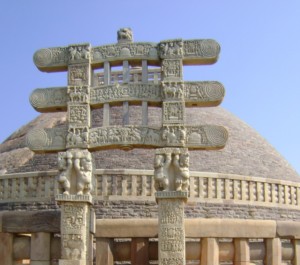It happened 2500 years ago…… Forsaking the luxuries of royal palace, Siddhartha Gautama, the prince of Kapilavasthu stepped out of the kingdom and began his journey in search of truth behind the misery of life. He travelled through the sacred land of India and finally under the Bodhi tree of Bodh Gaya he attained enlightenment and became Buddha. With infinite knowledge, fearless thinking and a heart filled with compassion, he taught the world how to overcome suffering and reach the ultimate goal of life without the interference of a personal god. Buddha came to this world not to eradicate any devil force or to reestablish dharma, but to save humankind from sufferings. For 80 years he lived and millions benefited from his teachings. Though Buddha did not care about god, his followers worshipped him as god incarnate. They established Buddhist pilgrimage sites across the world and erected statues and temples to honor him.
Most Significant Buddhist Pilgrimage Sites in India
There are a number of important Buddhist pilgrimage sites in the world of which four sites are considered to be the holiest. Among these, Lumbini, the birth place of Buddha is situated in Nepal, and the other three sites are in India, which are: Bodh Gaya, Sarnath and Kushinagar. These sites have witnessed the most important events in Buddha’s life and are dotted with a number of historical monuments that reverberate with the melodious chants of the rich Buddhist heritage. These are perfect pilgrimage spots you should visit, which will revitalize your soul and provide you everlasting moments of tranquility.
Bodh Gaya: the Land of Enlightenment of Buddha
Bodh Gaya, located in the state of Bihar, is the holiest of all Buddhist pilgrimage destinations in the world. It was at Bodh Gaya where Prince Siddhartha Gautama attained supreme knowledge to become Buddha, the enlightened one. The holy Bodhi tree, Mahabodhi temple and the colossal statue of Great Buddha are the major attractions of this site.
The 170 feet tall Mahabodhi temple built by Emperor Ashoka is an architectural marvel. It was abandoned with the decline of Buddhism in India and was later restored in the 19th century and renovated to restore to its former glory. Scenes from Buddha’s life are depicted on the walls of the temple and the entire complex is studded with a number of stupas of different sizes. The temple was declared a UNESCO World Heritage site in 2002.
The present Bodhi tree is supposed to be the fifth succession of the original Bodhi tree under which Buddha attained enlightenment. There is a stone platform called Vajrasan under the tree which was the seat of meditation of Buddha.
An 82 feet high Great Buddha statue built in the temple complex, which depicts Lord Buddha seated in meditative posture on a huge lotus in open air, is a major attraction of the site. Made of sandstone blocks and red granite, it was unveiled by the 14th Dalai Lama in 1989.
There are many other attractions including Bodh Gaya Museum, Lotus Tank, Shaivite Monastery and a number of other monasteries and temples built by different countries including Japan, China, Nepal, Tibet, Indonesia, Thailand and Cambodia, which reflect the architectural style and traditions of these countries.
Buddha Jayanti celebrated in the month of May is the most important festival of Bodh Gaya. This sacred Buddhist pilgrimage site is visited by millions of Buddhist pilgrims, monks and travellers from all over the world. Best time to visit Bodh Gaya is the cool and pleasant winter season, during October to February.
Gaya, a city of religious sanctity and a home to a large number of Buddhist temples, located around 12 km away from Bodh Gaya, has an international airport. Gaya railway station is well connected from different parts of the country. Bodh Gaya and Gaya are well connected by bus services from major cities.
Sarnath : the Land of First Discourse of Buddha
After attaining enlightenment in Bodh Gaya, Buddha went to Sarnath. At the Deer Park of Sarnath he delivered his first sermon to his five disciples, which is referred as ‘setting in motion of the Wheels of Dharma’ or ‘Maha Dharmachakra Pravartan’.
Sarnath, also known as ‘Mrigadava’ and ‘Isipatana’, is one of the most venerated Buddhist pilgrimage sites located at about 12 km from the holy city Varanasi in Uttar Pradesh. Buddha’s teachings and Buddhism flourished in Sarnath until the end of 12th century when Sarnath was attacked by Turkish Muslims. The site remained forgotten and abandoned till the 19th century when it was excavated and restored by the British rulers in India.
Dhamek Stupa or Dharma Chakra Stupa, a huge impressive structure, 128 feet high and 93 feet in diameter, is the major attraction of the site. Built in 3rd century BC by Emperor Ashoka, it has wonderful design and intricate floral carvings.
Mulagandhakuti Vihara, is a Buddhist temple with a nice garden and trees, where Buddha spent his first rainy days in meditation. Behind it is the famous Deer Park. There is a seated life size statue of Buddha and the temple walls have mural paintings reflecting scenes from Buddha’s life. You can see a Bodhi tree, which has grown from the cutting of the Bodhi tree from Bodh Gaya and also life-size statues of Buddha giving sermons to his disciples.
The famous Ashoka Pillar was broken during excavations and only the base with intricate carvings remains in its original spot. The spectacular Lion capital that crowned the pillar is now on display at Sarnath Archeological museum. It is an exceptional example of ancient Mauryan art and has been adopted as the National emblem of India.
The Archaeological Museum is a wonderful place that displays hundreds of antiques and sculptures belonging to the 3rd century BC to 12th century AD. The museum contains invaluable treasures of the art and architecture of ancient Buddhist culture.
Chaukhandi Stupa built in 5th century marks the spot where Buddha met his first disciples. An octagonal brick structure in Islamic style is added to it later to commemorate the visit of the Mughal emperor Humayun.
Dharmarajike Stupa is another popular Stupa built by Emperor Ashoka to protect the remnants of Buddha, the base of which is only seen now. You can see Buddhist monks of colorful robes meditating in its serenity.
There are several Buddhist temples of different countries including Japanese, Chinese, Tibetan and Sri Lankan. All of them have beautifully sculptured Buddha statues and unique decorations and architecture that depict the cultural heritage of the countries.
The best way to reach Sarnath is via Varanasi, which is at about 12 km by road. There is an international airport at Varanasi. Varanasi railway junction is well linked to the major cities of the country.
Kushinagar – the Land of Parinirvana of Buddha
Kushinagar, situated in the state of Uttar Pradesh is a sacred Buddhist pilgrimage site of great spiritual significance, where Buddha attained Parinirvana and became free from the cycles of birth and death. Also known as Kasia or Kusinara, it was the capital of Mallas kingdom in the 6th century B.C. and was subsequently ruled by different rulers, starting from Maurya to Harsha dynasties. It was abandoned in the 12th century with the decline of Buddhism in India and the historical relics were recovered by the excavations carried out in the 19th century.
Parinirvana Temple is one of the most visited Buddhist temples in Kushinagar, famous for the 6 meter long reclining statue of Buddha. Made of monolith red sandstone in the form of Lord Buddha reclining on his right, it is placed on a huge brick platform with stone pillars at the corners. The Nirvana Stupa, just behind the temple stands at 2.74 meter height.
Ramabhar Stupa also called as Muktabandhana Stupa, located at about 1.5 km from the Parinirvana Temple, is one of the most sacred Buddhist pilgrimage destinations in Kushinagar. It is believed to be the place of cremation of Buddha. It has a beautiful idol of Lord Buddha.
Mathakuar Shrine located near the Nirvana Stupa is famous for a colossal statue of Lord Buddha in the ‘Bhumi Sparsh Mudra” (earth touching attitude), the posture of the Lord under the Bodhi tree. It is carved in black stones in single block with an inscription at its base which dates back to the 10th or 11th century A.D.
The Japanese Meditation Park located near Parinirvana temple is a beautiful place filled with a number of Sal tree, greenery and artificial water bodies. It is a best place for relaxation and Meditation, which will rejuvenate your body, mind and soul.
The Wat Thai temple built in Thai Buddhist architecture style is another popular attraction of Kushinagar. Centrally located amidst a vast area of greenery, flowers and orchids, the temple can be seen from any place in Kushinagar.
In the Kushinagar Museum near the Sri Lankan Buddhist Center you can see a wide range of collection of statues, antiques, architectural remains, coins, etc., recovered from the excavated stupas and remnants. The statue of Lord Buddha in meditation posture built in the stunning Gandhara architectural style is one of the major attractions of the museum.
In addition, there are many popular temples including the Japanese Temple which has an ‘ashta dhatu’ (eight metal) statue of Lord Buddha; and a beautiful Chinese Temple which provides free accommodation facilities for the tourists.
Located at 51 km from Gorakhpur city, Kushinagar is easily accessible by road by buses and taxis. Gorakhpur railway station at 55 km is the Headquarters of North-Eastern railway and is well connected from all major cities of India. Gorakhpur airport is the nearest airport at 45 km from Kushinagar.
Apart from the above, there are many other important Buddhist pilgrimage centers in India at different locations including Sanchi, Dharmashala, Nalanda, Rajgir, Vaishali, Ajanta & Ellora and Amravati, to name a few. Each of these places is quite inspirational and serene. If you are thinking about a peaceful and relaxing vacation, then visit these sacred destinations; they will awaken the Buddha within yourself.






















I get benefits by hiring the car before that I read the terms and conditions of the car rental.
A very interesting and enlightening article. Makes me want to visit every one of these places. Thank you so much.
Thank you for your appreciation!
You reminded me of my own visits to some of these places like Bodh Gaya, Sarnath and Kushinagar etc.
@SUNY, Many thanks for your encouraging words!